Up Next
In Arcmanoro Niles’s Memory-Based Paintings, the Past Is in Technicolor
The artist's latest solo exhibition is on view at Lehmann Maupin, New York.
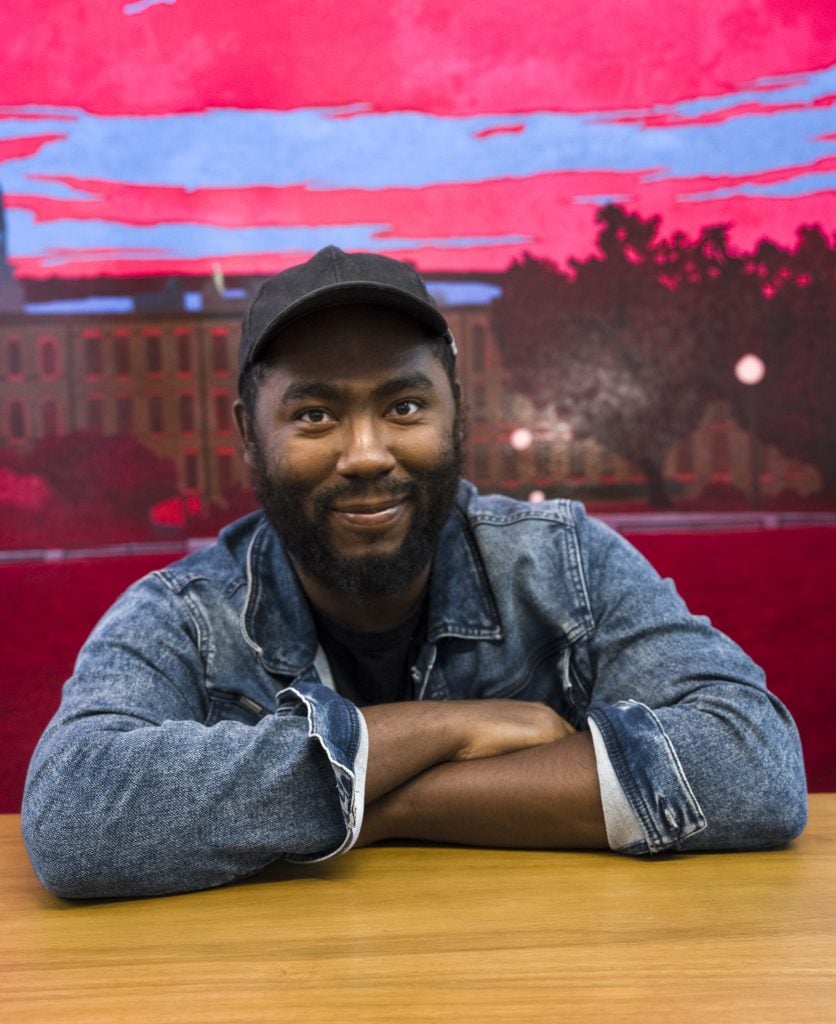
Imagine how you might paint a memory. While that may evoke hazy tones and disjointed vignettes, instead, the artist Arcmanoro Niles renders them in electric technicolor. Recollections of moments gone by are made vibrant and clear—but with such exceptional vividness and enough elements of surrealism to call into question what is based in reality, and what is instead based on emotional and psychological connections.
“My paintings are kind of like an album or a movie, almost like I’m writing a screenplay. It shows a moment in time, or a certain stage in life, that we all go through,” Niles described. “It’s in many ways autobiographical, but ‘based on true events’ would be the best way to describe it.”

Arcmanoro Niles. Photo: Daniel Kukla. Courtesy the artist and Lehmann Maupin, New York, Seoul, and London.
Originally from Washington, D.C., and based in Brooklyn, Niles is currently the subject of his fourth solo show with Lehmann Maupin, “The City Lights Can’t Shine Quite like the Stars: Got So Far From My Raising I Forgot Where I Come From,” on view through April 13, 2024. The shows “title tracks,” if you will, are two paintings that together offer a glimpse into the artist’s past.
Got So Far from My Raising I Forgot Where I Come From (Spent My Youth among the Pines) (2023) features the dazzling bright fuchsia that has become a sort of hallmark of the artist’s oeuvre. Showing Niles as a child with his father in a stand of partially felled trees, and a pastel camper trailer in the background, the work affords a private view into a childhood moment otherwise relegated to the artist’s mind. Across the gallery, in The City Lights Can’t Shine Quite like the Stars (2024) the shadowy tree line is visible via the faint glow of red light, perhaps from taillights.
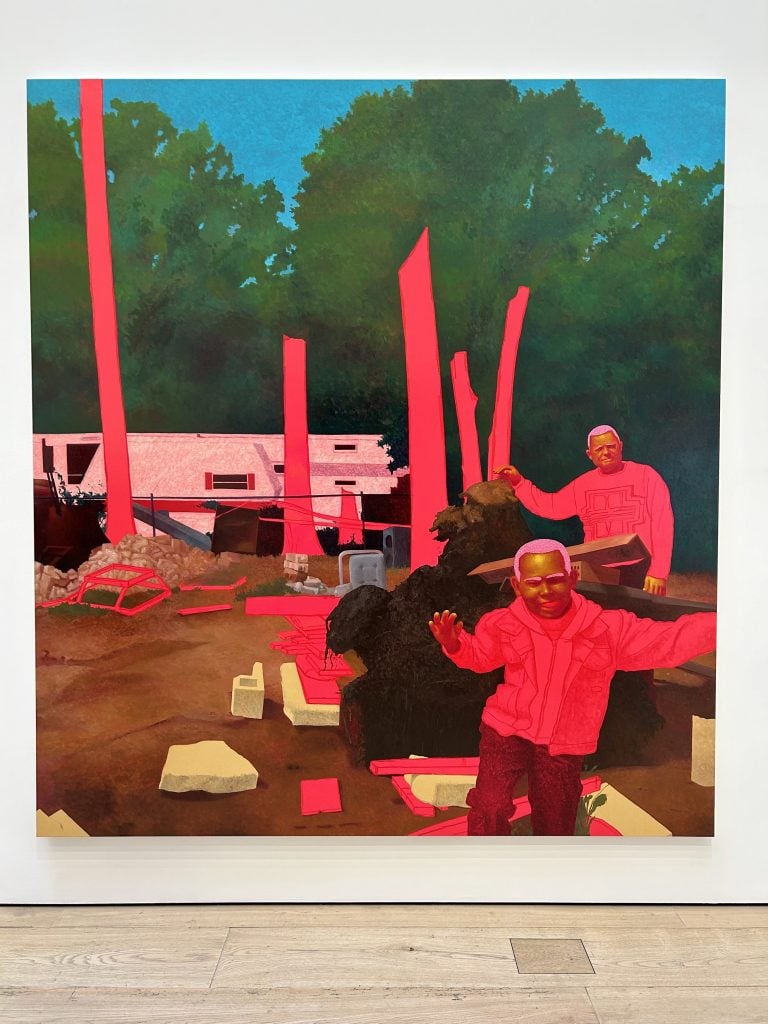
Arcmanoro Niles, Got So Far from My Raising I Forgot Where I Come From (Spent My Youth Among the Pines) (2023). Courtesy the artist and Lehmann Maupin, New York, Seoul, and London.
Unnaturally bright pinks and near-neon oranges, as well as glitter and metallic paint, crop up across Niles’s most recent work, made even more eye catching by their juxtaposition with colors and scenes from everyday life. And the starting point for these scenes is a diverse range of photographic materials Niles referenced—from old family photos and Polaroids to cellphone snaps—all of which are personal to him. Some of these images have been composited together, though any indication or delineation of melding is omitted, with only the painting’s dimensions and framing offering a small clue of what the original may look like.
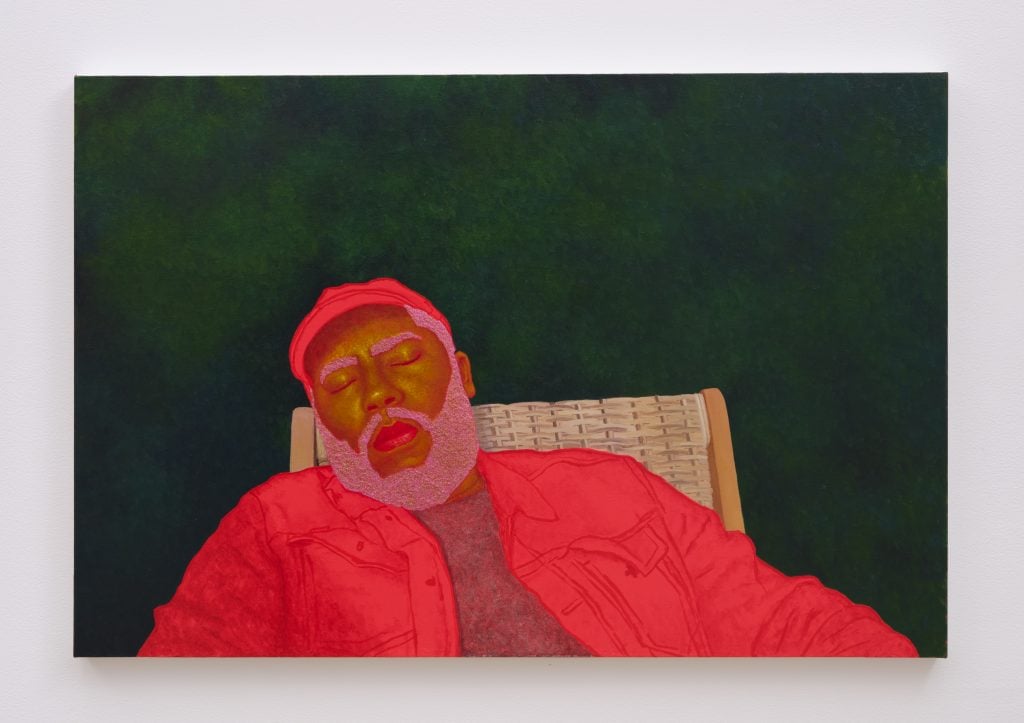
Arcmanoro Niles, I Never Liked the Quiet before (Let Me Find the Place Where I Fit) (2023). Courtesy the artist and Lehmann Maupin, New York, Seoul, and London.
The result is a body of work that makes time mutable; past and present coexist in each painting, bringing to the fore ideas around things forgotten, memory, a sense of place, or even a feeling whose name you can’t quite put your finger on. And while each composition offers a reimagining of something that once was, the title of each work is a poetic refrain that reads as deeply personal yet broadly relatable—and at times melancholic.
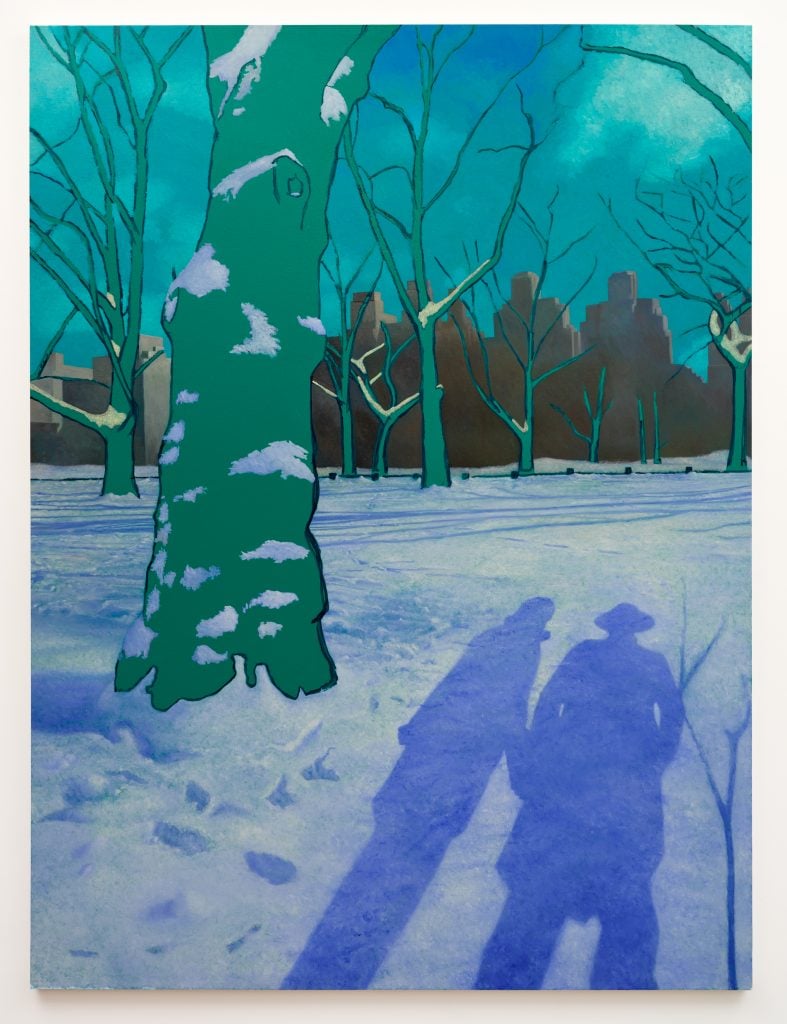
Arcmanoro Niles, Are You Listening to a Love Song about Someone New (Central Park and Things We Can’t Undo) (2024). Courtesy the artist and Lehmann Maupin, New York, Seoul, and London.
Within Are You Listening to a Love Song about Someone New (Central Park and Things We can’t Undo) (2024), the landscape is a highly recognizable (even when simplified) view from Central Park in New York, with the indexical shadows of the image taker—momentarily confusable to the viewer as themselves. Rather than adhere to strict notions of representation, which Niles noted was his initial intention, the trees across the scene are flatly painted a deep shade of teal, with only bits of clinging snow and minimal, gestural outlines of their contours conveying their position in space and time. The snow in contrast is meticulously rendered in myriad shades of blue and white with churned up outlines of footsteps and reaching shadows.
The title, two out-of-direct view figures, the season, and the place, all harmonize together and call forth both individual memory and shared experience, as well as the spaces wherein they overlap. Alluding to heartbreak and nostalgia, Niles connects with his viewer through a common desire to find meaning in life’s myriad experiences as well as hold on to the vestiges of what is now lost.

Arcmanoro Niles, Bracing for the Night (There’s Only Loneliness Insight) (2023). Courtesy the artist and Lehmann Maupin, New York, Seoul, and London.
The show also marks the artist’s first foray into sculpture with a modified telescope painted gold titled Praying to a God That Won’t Talk Back (2023).
“I’d been thinking about doing the sculpture,” said Niles, “but every time it kind of felt silly and ‘made up.’ With the type of figures I paint, I couldn’t see something in 3D because it’s so much about the skin glowing, the colors, and they only really work because the environment is turned up, everything around them is turned up.”
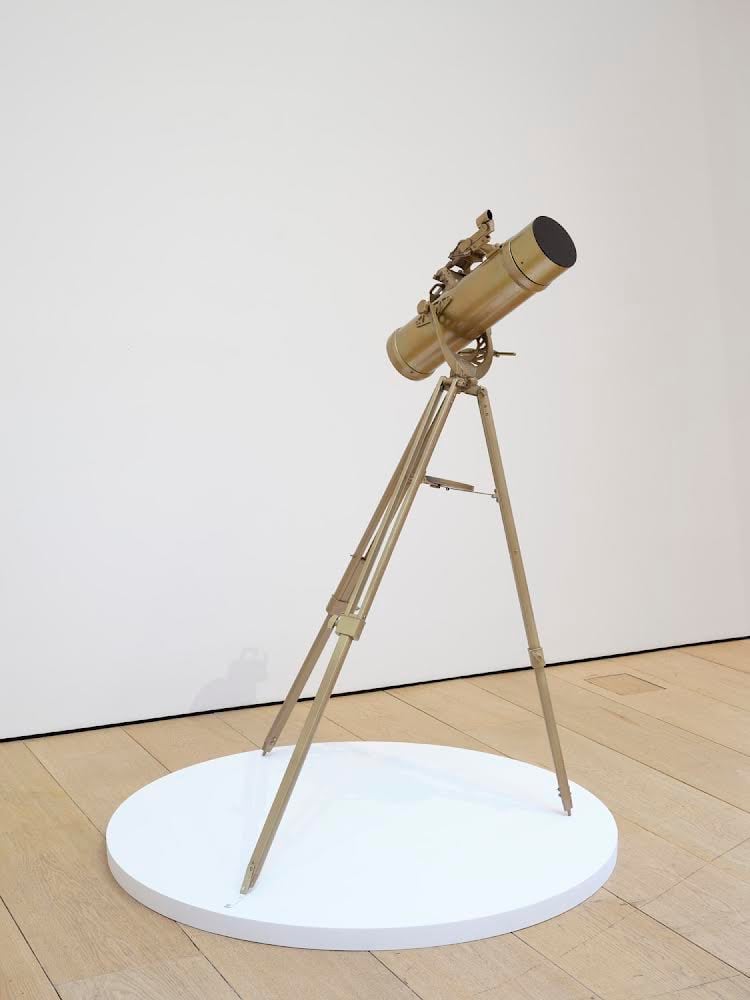
Arcmanoro Niles, Praying to a God That Won’t Talk Back (2023). Courtesy the artist and Lehmann Maupin, New York, Seoul, and London.
As a child, Niles would often craft his own toys out of found materials, like taking old telephone wires and a bottle to make an imaginary time travel machine. The present sculpture recalls his memory and impulse to create as a child, but also gives insight into his psychological process of painting. “The first time I looked through a telescope—or at least the first time I remember—I thought it’s kind of like when I’m thinking about painting. And I wondered if I could make this into a sculpture, and thought it’d be really cool if you could look into it and see the stars. So, I started trying to figure out how to do that,” Niles explained.
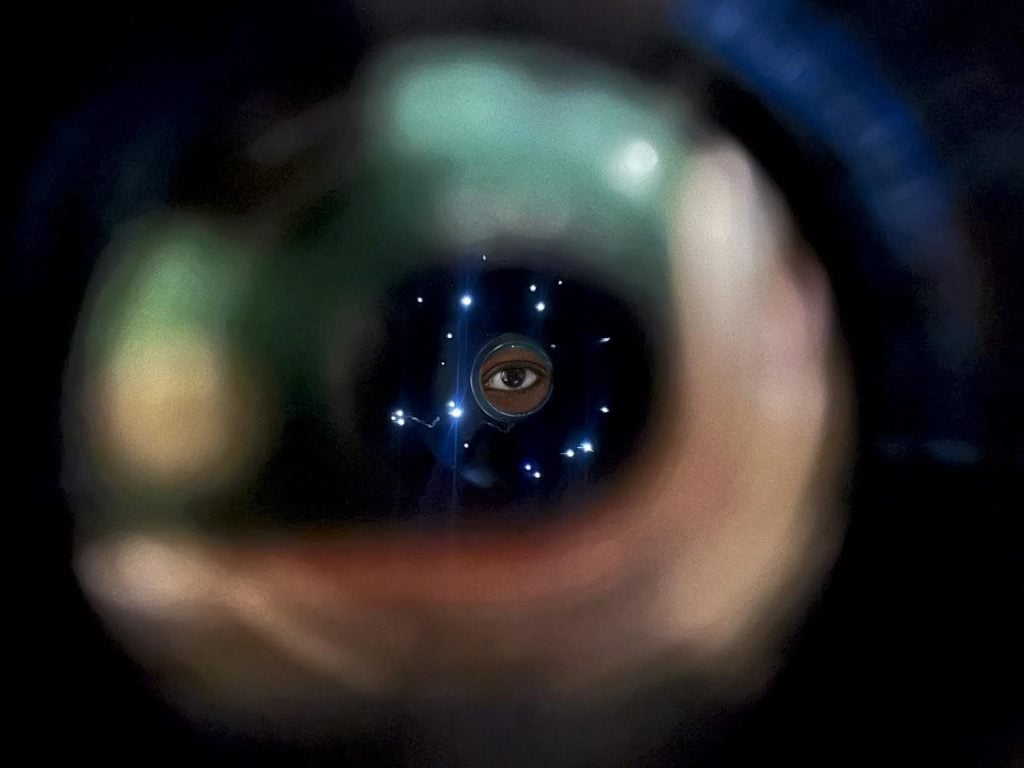
Arcmanoro Niles, interior detail of Praying to a God That Won’t Talk Back (2023). Courtesy the artist and Lehmann Maupin, New York, Seoul, and London.
Taking inspiration from the way Yayoi Kusama constructed her Infinity Mirror Room installations, Niles experimented with an old telescope, taking out its inside components and trying out various arrangements of plexiglass mirrors, glitter, and lights. “There was a lot of trial and error,” Niles laughed. Its success, however, seems to indicate sculpture may be a continuing part of his practice moving forward.
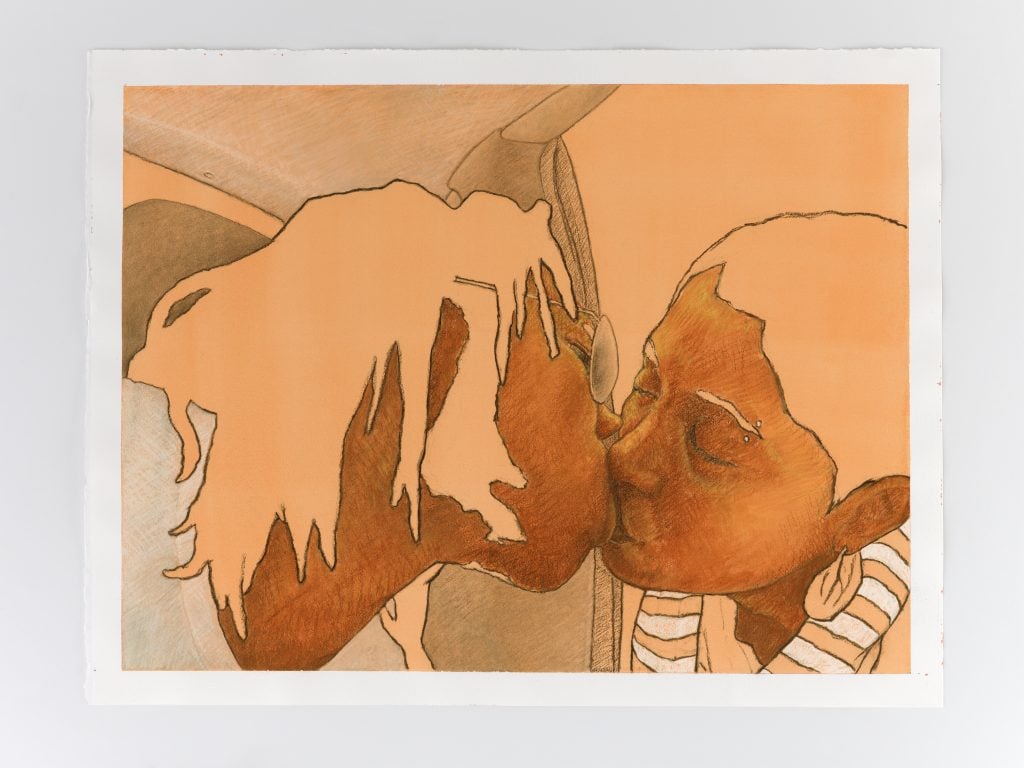
Arcmanoro Niles, Jack and Coke in My Grandfathers Car (It’s Never Nothing Like the First Time) (2023). Courtesy the artist and Lehmann Maupin, New York, Seoul, and London.
The second of two major solos with Lehmann Maupin in their New York location, Niles’s 2023 exhibition “A Moment Alone in the Shade” featured a series of works on paper perhaps most notably recognized for all being done on a bright orange ground. Like with the sculpture in the current show, the works on paper were a product of experimentation, or, as Niles describes it, a “technical accident.”
Unsatisfied with what he was able to achieve with charcoal on white paper, he began testing out Conté, a type of hard crayon made from graphite and colored clay. Referencing an old drawing he had done of his grandmother in Conté that was executed on a pastel orange paper, he tried using different shades of brown, and found success using a shade of tan paper as a support. This proved an issue, however, when he wanted to move to larger scale works, as he couldn’t order tan paper in rolls. Instead, he ordered a roll of white paper with the intent of dyeing it himself, but quickly realized this also meant he could dye it to any shade he might want.
“I did a few different colors, orange, blue, pink. What made the most sense was the orange. I’m someone who works in steps and build upon what comes next. I like to keep things simple, and then over time it gets more complicated. It gives me more control,” said Niles of the process. Orange was one of the first colors he fully explored in his paintings, and this was mirrored in his explorations with paper.
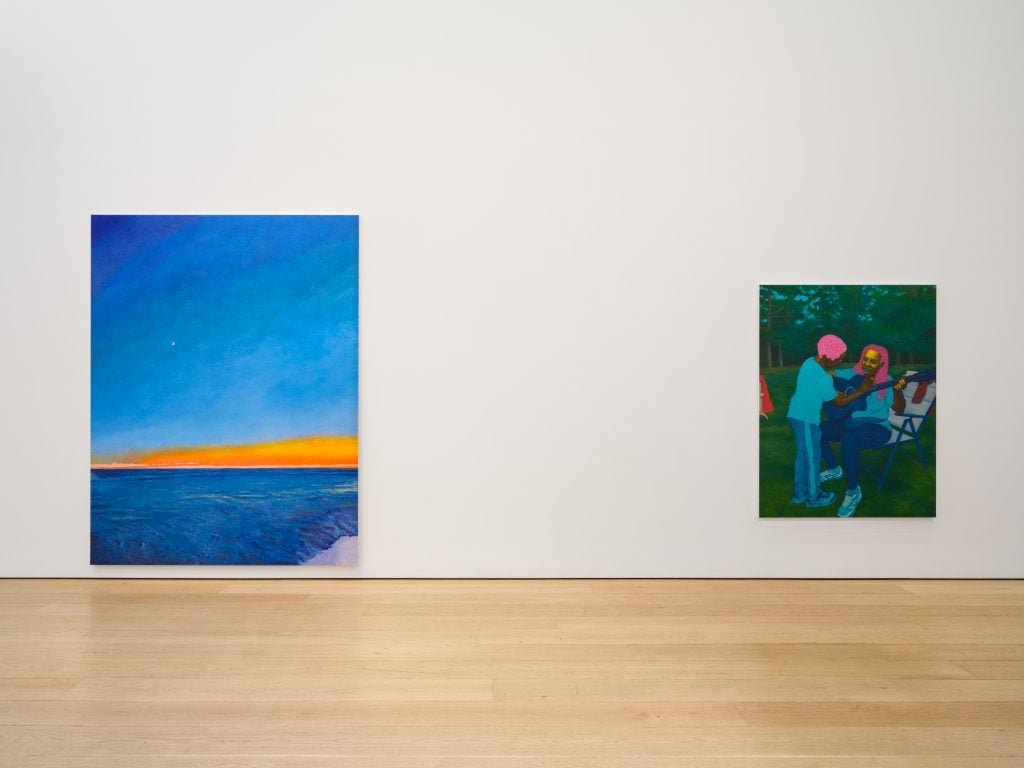
Installation view of “Arcmanoro Niles: The City Lights Can’t Shine Quite Like the Stars: Got So Far From My Raising I Forgot Where I Come From” (Lehmann Maupin, New York 2024). Lehmann Maupin, New York, Seoul, and London.
Visitors to both of Niles’ recent shows have been rewarded with a broader, visual understanding of the artist’s work and practice, tracing his evolving ability to not only create vibrant, almost glowing fields of color, but harness it as well in his explorations of time and memory.
While the show of drawings found a distinct coherence through their unified orange ground, the works in “The City Lights Can’t Shine Quite like the Stars: Got So Far From My Raising I Forgot Where I Come From” too find their own sense of cohesion through familial and thematic references while remaining distinct; “I didn’t think of this as a series,” he said. “it’s like with an album, where you have all the different songs individually, but they come together under one project umbrella.”
“You can take as much as you want, some people might just come and look at the paintings, someone might come and just look at the title. You can put it all together and make your own story. It allows a certain feeling to come across.”





